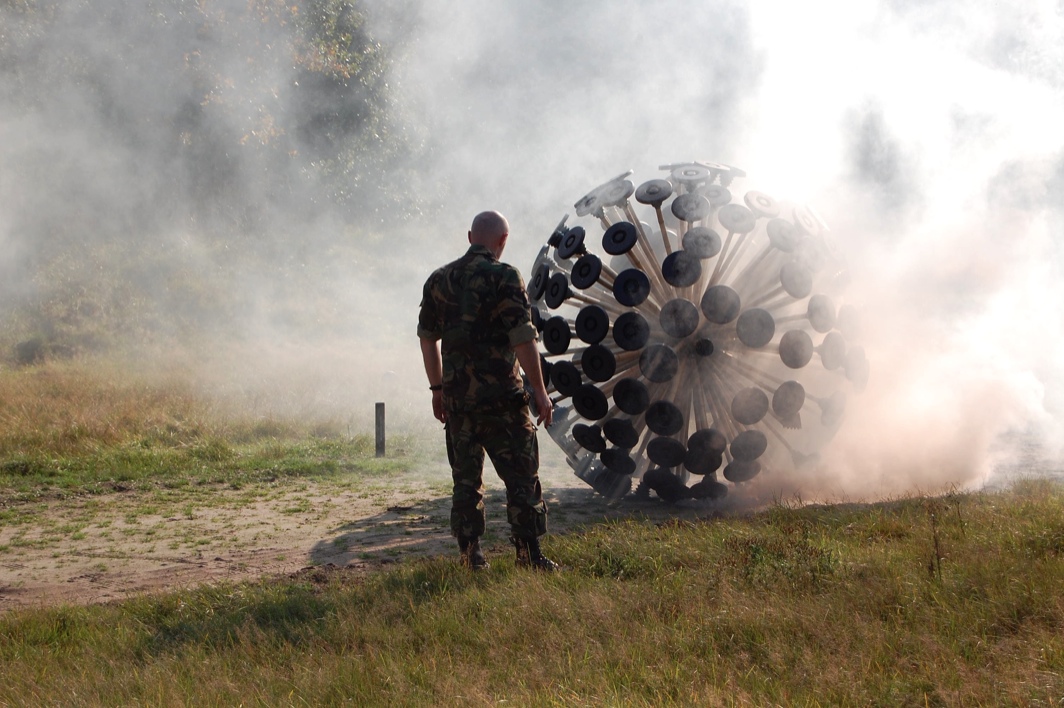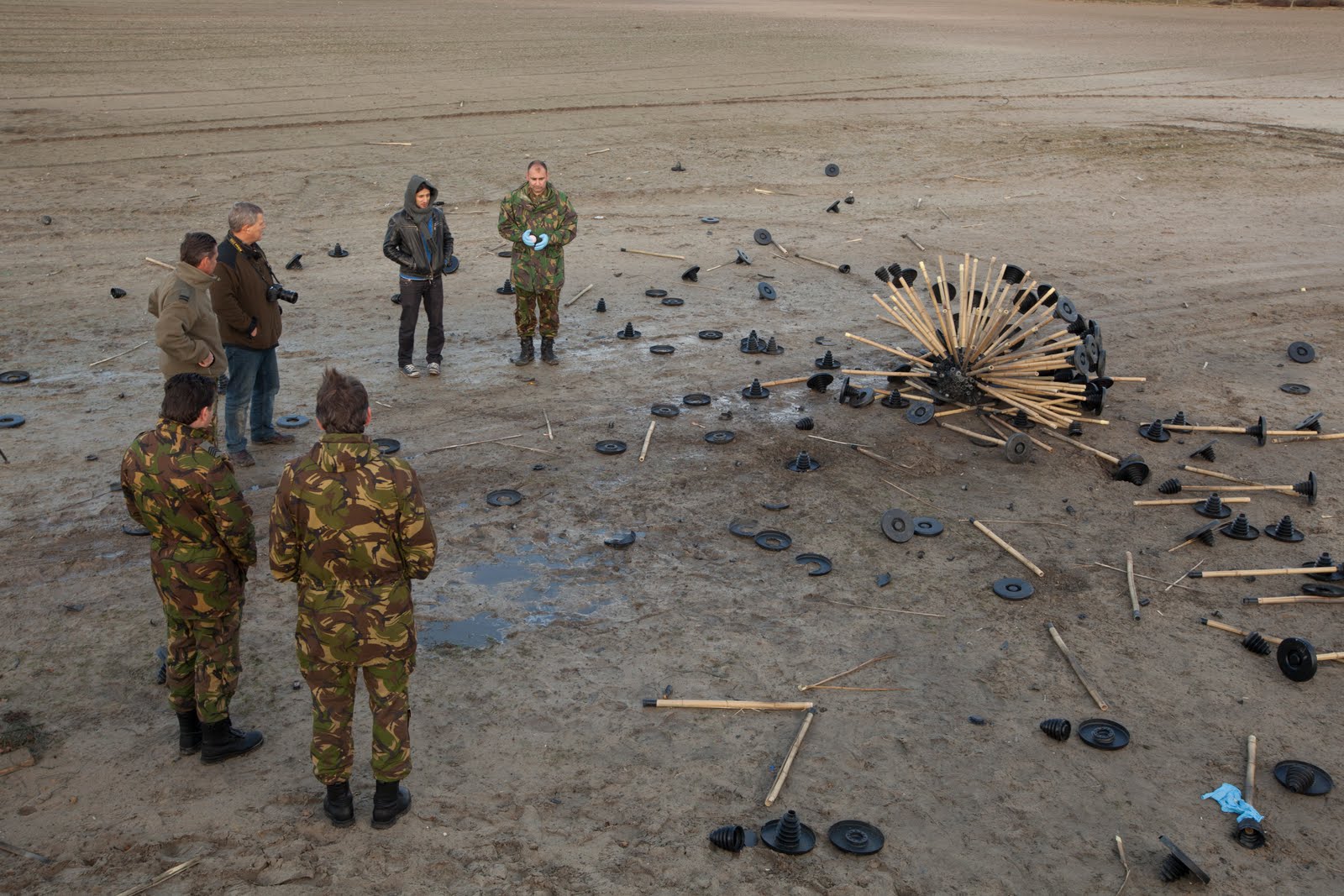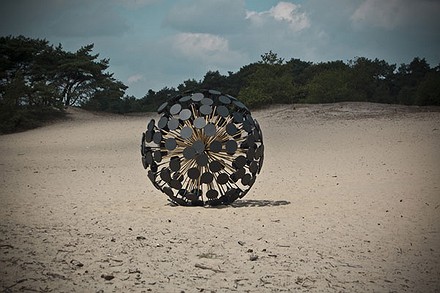Items Debate 1 – Mine Kafon
Good Intentions vs. Effectivity
Massoud Hassani: Mine Kafon, 2011
Pro
When I saw Massoud Hassani's Mine Kafon for the first time, I was immediately touched by the simple beauty of its design. A black flower, radiating fragility and strength at the same time. To wit, that was during the construction of the Design Academy Eindhoven's show in Milan in 2011. I'm head of the Market department at that academy, a department that tries to prepare students for everything they don't really want to know: financing, intellectual rights, presentation etcetera. In this capacity I had seen Massoud before, but the thing he graduated with was completely new to me.
The minimalistic impact of his design was deepened by an impressive and authentic story, which is meanwhile well known: a childhood memory from Kabul (toys drifting in the wind), which served as starting point for a contribution to the possible solution of human suffering – the dangers of land mines, well known to Massoud as an Afghan child.
Concurrently, it was clear to me that this was not only the brilliant finish of an education but also the complicated start of a career. Because it is obvious that this is a design that greatly depends on further technical development.
That requires money – something not readily available for creativity and innovation in the Netherlands – and time, which a young designer doesn't have in great measure, because he first needs to build a portfolio.
Many visitors of the Design Academy's graduation shows – last year almost 30.000! – view the projects on display as commercial end products. Of course, they often aren't. More often they are the outcome a period of investigation and research, which, according to his tutors, the student has fulfilled in a satisfactory manner with surprising, inspiring and sometimes innovative result. Massoud, for instance, also graduated with a series of beautiful cooking pots, next to his Mine Kafon.
The fact that the Mine Kafon does not work yet is undeniable. The expectation that this will not happen in the future either, expressed by some critics, is, however, speculative. This form is obviously not the end form of the design. The techniques used are not the definitive ones. Everything will depend on the professional support Massoud will be able to generate. That's how innovation works! I would not have been keen on riding Leonardo da Vinci's first bicycle design through today's traffic either.
All of this does not affect the iconic value this design appears to have or acquire. The enormous public and professional interest in the Netherlands and abroad is a clear indication of appreciation for the passionate engagement of young designers like Massoud in contribution to solving 'wicked problems'; in not only enriching the lives of the happy few, but also those of the unhappy many. As professionals, we cannot – and should not – reply with cynicism. We didn't, after all, when a previous generation presented 'Dutch Design Icon Furniture'. Incidentally, Dick van der Kooy, a DAE classmate of Massoud, attracted at least as much press attention with his 'Endless Chair', so also this tradition lives on.
Since I was confronted at seventeen with the possible amputation of my complete left leg (which was thankfully not deemed necessary afterward), I am acutely aware of the fact that loosing one or more limbs does not mean the end of one's life, but that it does imply the start of a life-long impairment. If in all its simplicity the Mine Kafon prevents even one soccer-playing Angolan boy's or one skipping Afghan girl's future to be blast to pieces, then this design has been more than successful.
Walter Amerika

Contra
Massoud Hassani's Mine Kafon design is well on its way of becoming a new icon of Dutch Design. If so, the product will be a successor to Marcel Wanders' Knotted Chair, the icon of the 1990s, and Maarten Baas' Smoked series of burnt furniture, the Dutch Design icon of the early 2000s. It would also be proof to the fact that Dutch Design is not a matter of national character – Hassani is from Afghan decent –, but can be learnt.
At first sight Mine Kafon fulfills all criteria of good design. The product de-activates landmines, so its social relevance is warranted. It is a sustainable product as well, because it is propelled by the wind and can be easily repaired. It is also a fine example of the integration of low- and high-tech; its stems and synthetic stamps can be made almost anywhere, and satellite navigation is a ubiquitous and relatively inexpensive technology. Its formal design is poetic rather than threatening and makes a nice contrast with the device's grim function.
Still, there is something deficient in the Mine Kafon's concept. The idea of an autonomously and randomly moving mine-clearing device is at odds with a basic principle of mine clearance: its systematic approach. With the Mine Kafon, you can never be completely sure an area is totally free of mines. The device can never replace manual clearance of land mines. The concept suffers from the same flaw as wind energy; you will always need a back-up form of energy production, because you can never be sure the wind will blow strongly enough to fulfill the demand for energy. The Mine Kafon comes to a halt when the wind stops blowing. If it's windy, the device is blown into a certain direction with a considerable chance of becoming stuck somewhere or ending up in a ditch.
The only thing one can prove with a Mine Kafon is the mere presence of land mines in a certain area – provided that it meets a mine and detonates it. Then you know that there was a mine, at that exact spot. Whether the trajectory the Mine Kafon followed previously is mine-free, is uncertain because satellite navigation is not accurate enough to document the device's exact route to the centimeter. This accuracy is, however, needed because anti-personal mines can be no larger than a can of shoe polish. The Mine Kafon provides inhabitants of a mine-infested area with a fake sense of safety, which can even lead to more instead of less victims.
Iconic products like the Knotted Chair or Philippe Starck's Lemon Squeezer share the characteristic of subordinating functionality to conceptual or symbolic qualities. But functionality is never totally absent. In the Mine Kafon it is. It looks like the Mine Kafon's fans have suspended their critical capacities, blinded by the designer's good intentions and the poetic formal design of the product. But Dutch Design should really be looking for another icon.
Marc Vlemmings





